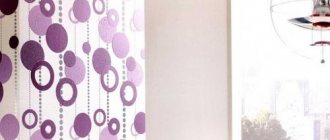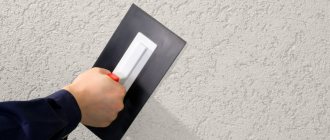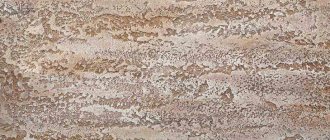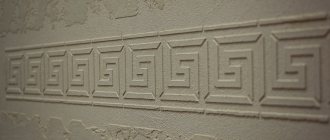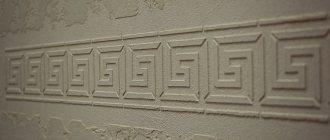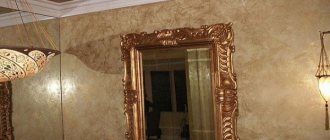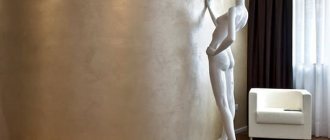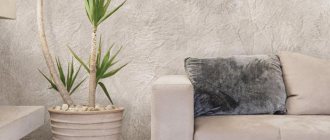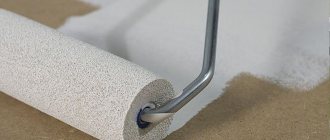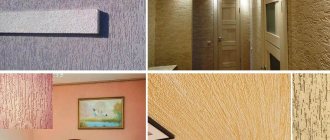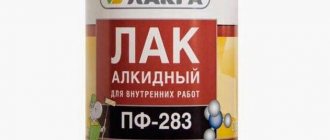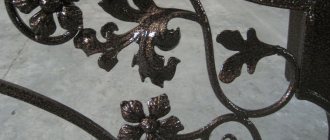Hi all! Plaster is a popular material for cladding facades and interior walls. When working with many paints and plaster materials, the surfaces are pre-primed. Is it necessary to prime the bark beetle before painting?
If you saw it, I already wrote about painting the bark beetle, and also talked about the bark beetle plaster itself.
But I practically didn’t mention the use of primers. It's time to fix the situation.
If you are ready, then I will begin. You can take something tasty, or get ready to write it down and remember it.
Is it necessary to prime the base before the bark beetle?
Priming the surface before applying the finishing material is carried out in order to improve the adhesion of the building mixture to the base. After treatment, the wall does not absorb liquid. When the master begins to apply the mixture, moisture does not leave it. This allows the bark beetle to be evenly distributed over the wall, preventing the material from rolling. The improved interaction of the finishing composition with the treated base further helps reduce the financial costs of purchasing the former. Any solution that has fallen to the ground cannot be used.
If the base is loose and porous, then the primer will increase the strength of the surface layer. Bark beetle applied to an untreated wall will not last long. It may crumble during operation, i.e. even before full setting occurs. The primer will strengthen the wall and prevent part of the applied finishing material from peeling off along with a fragment of the base.
The water-repellent properties of the primer will provide protection from the destructive effects of precipitation. Thanks to this, the façade of the building will retain its technical and heat-insulating characteristics. Also, the waterproofing and antibacterial properties of the primer will prevent the appearance and proliferation of fungal microflora.
Recommendations for choosing colors
Painting the facade implies a harmonious combination of all elements of the building, which will help emphasize individuality.
Therefore, when choosing a color scheme, you must adhere to certain rules for combining shades.
- For the facade, it is better to choose pastel-colored paint, which will help it blend organically into the overall design, while it is easier to choose the shade of the roof. To avoid monotony, you can use the selected color in two different shades.
- If you plan to make the facade multi-colored, then you need to select shades that are harmonious with each other, which will help organize the diversity.
- It is better to make the color of the walls lighter than the shade of the roof, although the opposite option is possible. But it can only be realized with the help of a professional designer or architect.
What primer to use
The primer for decorative plaster is selected depending on the base. Additionally, the scope of application should be taken into account. Primers are designed for interior and exterior finishing. Compositions suitable for indoor use are characterized by a high degree of safety, i.e. they are environmentally friendly.
Adhesive
The degree of intermolecular interaction between the wall and the applied composition is an important criterion when choosing a primer. Therefore, if the wall is, for example, concrete, then preference should be given to adhesive primers. Their compositions contain dispersed filler (sand). Thanks to it, good adhesion between the base surface and the bark beetle is achieved. When using adhesive solutions, even a poorly prepared (dusty) base will be strengthened and will adhere well to the finishing solution.
Deep penetration
Primers with such characteristics are intended for good impregnation of the base. Such primers do not contain large dispersed particles, but the liquid itself has binding (gluing) properties. Construction mortars can saturate the base up to 10 cm.
After applying the primer, the pores on the wall close. Thanks to this, the base is strengthened and the consumption of building material is reduced. Additionally, the primer may contain substances that prevent the appearance and proliferation of fungus. Deep penetration formulations are well suited for old bases that are crumbling.
Universal
The universal product creates a uniform film on the surface, increasing adhesion and equalizing the absorption of the applied composition.
Despite the fact that the primer has several functions at once (strengthens, improves adhesion and creates a protective film), it is recommended to be used for processing:
- concrete;
- drywall;
- wood;
- plasters;
- old brick, etc.
Types of paint
The façade finishing with bark beetle must withstand the negative effects of ultraviolet rays and various types of precipitation and at the same time retain its decorative qualities. Therefore, painting should be carried out taking into account the further load on the coating.
Optimal types of paints for external work:
- acrylic;
- silicate;
- silicone.
Each of them has a high level of moisture resistance and vapor permeability. In addition, their color range allows you to choose the optimal shade in combination with the roof. When facade paints dry, they form a top layer that protects the coating from temperature changes and precipitation. Initially they are white, and then they are tinted according to the shade table from the manufacturer.
When painting interior walls, the main selection criteria are environmental friendliness and safety. Therefore, wear resistance takes a back seat.
The main types of paints for painting “bark beetle” inside a building:
- water-based,
- acrylic;
- latex.
The last two options are best used in rooms with high levels of humidity (kitchen, bathroom), since their wear resistance allows them to withstand this load. Subsequently, the surface of the coating can be strengthened using a finishing layer of varnish.
The best way to paint the “bark beetle” is up to everyone to decide for themselves, but when purchasing, you should pay attention to the specific purpose. Since interior paint is not able to withstand external conditions, it will subsequently lose all its decorative qualities.
Manufacturers
When choosing an adhesive primer, you can choose the following products:
- Knauf-concrete contact;
- Perfecta;
- Tikkurila Otex;
- VGT.
The following deep penetration formulations have proven themselves to be effective:
- Perfecta;
- Litokol;
- Reference.
They respond positively to the Finnish-made universal plaster Dufa Putzgrund.
You can also use the following formulations:
- Ceresit CT-17;
- Knauf-Tiefengrund;
- Optimist.
Application
The use of a primer based on quartz sand requires compliance with the rules.
- A roller or wide, thick brushes are used instead of spray guns and spray guns (sand fractions can clog holes).
- Priming work is carried out at a temperature not lower than +5°C.
- The solution must be thoroughly mixed at least every 25-30 minutes.
- It is necessary to clean the surface of all excess (with a spatula, wire brush, rag, vacuum cleaner).
If necessary, water can be added to the primer, but it should not be more than 10% of the total composition.
To work with ceilings, when a thick layer of primer (about 5 mm) is needed, mesh reinforcement of the surface is first used.
When working with drywall, a multi-layer coating is recommended, for example, quartz primer - putty - quartz primer - paint layer. Before starting, check the instructions on the package. The primer may take about 12 hours to dry.
Application technology
After the primer for the decorative bark beetle plaster has been selected, it is necessary to properly prepare the base. Despite the fact that the primer glues dust particles together, before applying it you need to clean the wall of cobwebs, dirt and other debris. If there are defects on the surface, they should be eliminated. The cracks are widened by removing the damaged part and then repaired.
If the bark beetle primer is concentrated, then before treating the wall it must be diluted with water. The working staff is prepared according to the instructions. If the primer is not concentrated, then it can be used immediately, after shaking.
The primer is poured into a ditch, a roller is dipped in it and the wall is rolled. When the composition dries, it is necessary to repeat the treatment. The recommended number of layers is indicated on the primer packaging. After drying, begin applying the finishing material.
For plastering with bark beetle, you can use dry or ready-made mixtures. In the first option, the solution is made according to the manufacturer's instructions. Ready-made formulations must be stirred well before use. For convenience, it is better to use a mixer (a special attachment for a drill). If the solution is prepared independently, then after adding liquid it is allowed to stand for 5-10 minutes, then mixed again and started working.
It is not recommended to prepare a lot of solution at once, because... The mixture must be worked out within 1-2 hours. If the composition stays in the bucket longer, it will lose its properties, i.e. you'll have to throw it away.
Using a trowel or small spatula, the bark beetle is applied to the metal blyft and then transferred to the wall. To reduce material consumption, it is recommended to work from the bottom up. The layer should not be too thick. The building mixture is leveled over the surface of the wall with a blift, and then they immediately begin to create the texture. Decorative plaster should not be allowed to dry out. Otherwise, you won't be able to achieve a beautiful drawing.
The texture of the bark beetle is made using a plastic blift. The movements of the tool will depend on what kind of pattern you need to achieve. If a “rain” texture is required, then use a tool to smooth the working surface vertically. When performing the “slanting rain” pattern, work diagonally. If you move the blift in a circle, you get a “bark beetle”; when alternating horizontal and vertical movements, you get a “carpet”; in circular motions with varying degrees of pressure, you get a “lamb”. You can make a horizontal drawing, etc.
If the working surface is large, i.e. The composition cannot be applied to it immediately without interruption; the wall is divided into zones. The division of the wall is carried out using masking tape. The bark beetle is applied up to the dividing line, with a slight approach to it. When work continues, remove the tape and apply the mixture. This technology allows you to hide the joints.
Minuses
The main disadvantage of painting bark beetles is the laboriousness of the process. This is due to the fact that the coating has an uneven structure and requires careful processing of all recesses.
The main difficulties when carrying out painting work:
- When using a short-haired roller, it is impossible to reach all the recesses, so part of the plaster remains unpainted. This spoils not only the aesthetic appearance, but also negatively affects the wear resistance, since part of the coating will remain unprotected.
- Painting with a long-haired roller is also difficult, since the tool will capture too much of the working solution. This means that the excess, without having time to dry, will flow down. This leads to the need to use additional tools to correct smudges, which will significantly complicate and delay the process.
The optimal solution is to use rollers and sponges together, but before starting the procedure you need to practice on a small area of the wall.
Priming the bark beetle
To extend the service life of the decorative finish, it is recommended to treat it with a primer. The protective coating is applied after the construction mixture has completely dried. In most cases, a universal primer for bark beetles is chosen. But when, after processing the base layer, another type of primer remains, for example, adhesive, then you can use that too.
A primer is necessary regardless of whether the wall will be painted or not. The base tone of the bark beetle can be white or gray (if a colored composition is not already used). Therefore, if the wall is to be painted, then before performing decorative finishing, a primer is also applied to the surface. Thanks to it, the ceiling is strengthened. The paint applies evenly to the primer, and its consumption is reduced.
Before treating the wall with a primer, you can add a coloring pigment to the solution (it must match the selected tone).
Main advantages of the procedure
Painting bark beetle plaster provides a number of benefits.
- A wide range of colors allows you to implement various design solutions by experimenting with mixing different shades.
- Surface treatment creates a reliable protective layer, which significantly increases resistance to the negative effects of external conditions.
- The textured structure of the plaster makes it possible to paint it in two colors, which cannot be achieved when finishing the building with another coating.
- The paint creates a dirt-repellent barrier, which allows the facade to remain clean and attractive at any time of the year.
Purpose of the product
This primer is also called concrete contact, which reflects its main function of providing adhesion to various substrates. The porous concrete surface illustrates the problem of using plaster on such a base. It is precisely the task of ensuring a bond between the rough coating and the decorative layer that a primer with a quartz filler is oriented towards, and both putty and tile adhesive with a low astringent function can be used as a finishing material. The same applies to the foundation. In addition to cement, limestone, wood chip and gypsum surfaces are notorious for poor adhesion.
In addition, a quartz-based base primer not only increases the adhesion of materials, but also adds to the insulating function, which is especially important in relation to facades
Operating restrictions
Quartz soil has its own characteristics, which determine not only the area of application of the mixture, but also restrictions on application. Professionals do not recommend using the solution in the following cases.
- Only one type of primer is allowed in one room. Several types cannot be applied at once.
- Do not apply quartz mass to plastic and metal materials. This is due to the lack of absorbency of such surfaces. After drying, the sand falls off.
- Direct sunlight on walls treated with quartz primer disrupts the structure and reduces the quality of finishing work. Once dry, the sand may flake off.
- The mixture can only be used to cover walls; a sand-based solution is not suitable for ceilings. Because if it is accidentally soaked in water, the primer will peel off.
- Do not apply the suspension in conditions of high humidity.
- In frosty conditions and at ambient temperatures above + 30 degrees, it is better not to use quartz soil. Because it is impossible to calculate how long the solution will take to dry.
Nuances and tips
When working with quartz soil, there are certain nuances that both beginners and experienced craftsmen should remember.
- You cannot use spray bottles to apply the solution, because small particles of the suspension will clog the holes of the spray gun.
- The best time of year for repairs is summer, given the optimal climatic conditions for drying the mixture.
- Do not treat frozen walls - when thawing, excess moisture will destroy the soil layer.
- You can dilute the solution with water in an amount of 10% of the total mass.
On average, 10 liters of soil is enough to treat about 40 square meters of walls.
Nuances and tips
When working with quartz soil, there are certain nuances that both beginners and experienced craftsmen should remember.
- You cannot use spray bottles to apply the solution, because small particles of the suspension will clog the holes of the spray gun.
- The best time of year for repairs is summer, given the optimal climatic conditions for drying the mixture.
- Do not treat frozen walls - when thawing, excess moisture will destroy the soil layer.
- You can dilute the solution with water in an amount of 10% of the total mass.
On average, 10 liters of soil is enough to treat about 40 square meters of walls.
